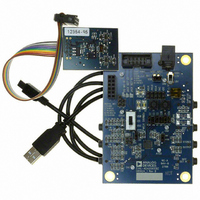EVAL-ADAU1761Z Analog Devices Inc, EVAL-ADAU1761Z Datasheet - Page 79

EVAL-ADAU1761Z
Manufacturer Part Number
EVAL-ADAU1761Z
Description
Eval Board For ADAU1761
Manufacturer
Analog Devices Inc
Series
SigmaDSP®r
Specifications of EVAL-ADAU1761Z
Main Purpose
Audio, CODEC
Embedded
Yes, DSP
Utilized Ic / Part
ADAU1761
Primary Attributes
Stereo, 24-Bit, 8 ~ 96 kHz Sampling Rate, GUI Tool
Secondary Attributes
I²C and GPIO Interfaces, 2 Differential and 1 Stereo Single-Ended Analog Inputs and Outputs
Silicon Manufacturer
Analog Devices
Core Architecture
SigmaDSP
Silicon Core Number
ADAU1761
Silicon Family Name
SigmaDSP
Application Sub Type
Audio
Lead Free Status / RoHS Status
Lead free / RoHS Compliant
Available stocks
Company
Part Number
Manufacturer
Quantity
Price
Company:
Part Number:
EVAL-ADAU1761Z
Manufacturer:
Analog Devices Inc
Quantity:
135
R42: Jack Detect Pin Control, 16,433 (0x4031)
With IOVDD set to 3.3 V, the low and high drive strengths of the JACKDET/MICIN pin are approximately 2.0 mA and 4.0 mA, respectively.
With IOVDD set to 1.8 V, the low and high drive strengths are approximately 0.8 mA and 1.7 mA, respectively. The optional pull-up/
pull-down resistors are nominally 250 kΩ. When enabled, these pull-up/pull-down resistors set the input signals to a defined state when
the signal source becomes three-state.
Bit 7
Table 76. Jack Detect Pin Control Register
Bits
5
[3:2]
R67: Dejitter Control, 16,438 (0x4036)
The dejitter control register allows the size of the dejitter window to be set, and also allows all dejitter circuits in the device to be activated or
bypassed. Dejitter circuits protect against duplicate samples or skipped samples due to jitter from the serial ports in slave mode. Disabling
and reenabling certain subsystems in the device—that is, the ADCs, serial ports, SigmaDSP core, and DACs—during operation can cause
the associated dejitter circuits to fail. As a result, audio data fails to be output to the next subsystem in the device.
When the serial ports are in master mode, the dejitter circuit can be bypassed by setting the dejitter window to 0. When the serial ports
are in slave mode, the dejitter circuit can be reinitialized prior to outputting audio from the device, guaranteeing that audio is output to
the next subsystem in the device. Any time that audio must pass through the ADCs, serial port, sound engine/DSP core, or DACs, the
dejitter circuit can be bypassed and reset by setting the dejitter window size to 0. In this way, the dejitter circuit can be immediately
reactivated, without a wait period, by setting the dejitter window size to the default value of 3.
Bit 7
Table 77. Dejitter Control Register
Bits
[7:0]
Bit Name
JDSTR
JDP[1:0]
Bit Name
DEJIT[7:0]
Reserved
Bit 6
Bit 6
JACKDET/MICIN pin drive strength.
Description
0 = low (default).
1 = high.
JACKDET/MICIN pad pull-up/pull-down configuration.
Setting
00
01
10
11
Description
Dejitter window size.
Window Size
00000000
…
00000011
…
00000101
Bit 5
JDSTR
Bit 5
Bit 4
Reserved
Bit 4
Core Clock Cycles
0
…
3 (default)
…
5
Configuration
Pull-up
Reserved
None (default)
Pull-down
Rev. C | Page 79 of 92
DEJIT[7:0]
Bit 3
Bit 3
JDP[1:0]
Bit 2
Bit 2
Bit 1
Bit 1
Reserved
ADAU1761
Bit 0
Bit 0





















